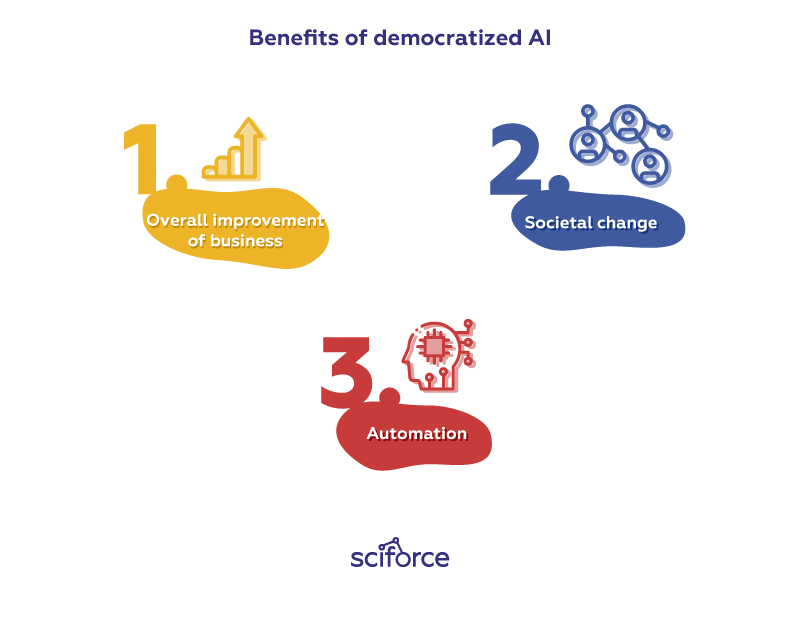In the last decades, we’ve seen tremendous advancements in Artificial Intelligence (AI) and related fields. It is viewed not only as a ground-breaking technology, but as a step forward to the future having the means to change our society. We expect AI to use hardware and software to see and hear patterns, make predictions, learn and improve, and take action with this intelligence. Some enthusiasts believe that AI can be a tool that will guide us to a better world showing how to achieve more. In this context, new questions have been raised of power and pervasiveness of such technologies. However, many IT companies claim that AI will democratizeAI and will make it available “for every person and every organization”, open to developers and researchers around the world. But does AI really democratize our world? And is it only a positive development?
What does AI democratization mean?
When we say that something is democratized, we imply that all people can access it and benefit from it. In enterprise IT, to democratize AI means to make it accessible for every organization or even to every person within the organization. Such dissemination of AI is indeed beneficial in many respects:
Benefits of democratized AI
- Overall improvement of business — AI currently encompasses cloud suites, NLP-based virtual assistants to run business, improve customer’s experience and increase stats;
- Societal change — as the awareness and the usage of AI grows, it gains more power to address global issues, like fighting climate change, tracking police work to avoid unfair targeting, or developing new standards in healthcare;
- Automation — Gartner predicts that many of these tools will be automated, offering a completely new level of self-service that will free up companies’ potential.

“Is AI Democratization a Real Thing”
What do we see today?
It is true that many companies, first of all tech startups and market giants, deploy artificial intelligence of some kind: machine learning does their predictions, natural language processing is improving their communication with clients, and sophisticated deep learning algorithms detect anomalies in their processes. However, many companies do not have the resources to build AI of their own and have to rely on cloud technologies to fill the gaps. For companies that are not tech-savvy, AI often feels complicated or overwhelming and it can be downright expensive, especially when engaging data science.
In this context, big tech firms end up way ahead of the curve, other enterprises can hardly catch them up, or even benefit from AI. To understand whether true AI democratization is achievable, let’s discuss what aspects of the market and inherent characteristics of AI add to inequality and what measures are taken to make AI available for everyone:
Data is the King
Data is the key to successful AI-driven intelligence and the more data we create, fuelling the so-called new “data economy”, the smarter products and services we can develop. Data seems to be an increasingly important asset and often the only significant advantage over the competition and as a result it is vigorously kept private;. Undeniably, having access to all data produced by your devices or every trace of your digital presence and being able to cross-correlate them across different platforms, services and people give an enormous power. To understand the scale, we can think of the monopolizing presence of IT giants like Facebook or Google in our daily digital life. This is completely rightful and strategically sound, but unfortunately completely in contrast with the AI democratization process.
We are promised that the monopolizing effect is mitigated by new algorithms that offer insightful predictions even with limited datasets. However, best results are still achieved with gigantic amounts of data, so to make AI available to everyone, we first need to make data available to every interested party via open and shared datasets. AI democratization can not work if we do not democratize data first.
At the same time, access to data is only the first step towards AI democratization, since it is not the amount of data that wins the competition, but the ability to use it.
Technical Illiteracy
In many cases, we do not think of the amount of digital data we produce in the world where every “like” on Facebook counts. At the enterprise-level, companies that are not technically savvy, are easily misled by complicated Ai solutions. Major AI companies intentionally take advantage of the common illiteracy in AI by oversimplifying and even undermining more serious AI democratization approaches. Similarly to data ownership, concerns are raised on the dangerous monopolization of AI technologies by only a few organizations.
Network Effect
An extension of such monopolization is the “network effect”, a social and economic phenomenon where an increased number of users improves the value of a good or service in turn attracting more participants and triggering a virtuous cycle. This effect makes the situation even more unequal, as the tech giants gather most of the participants, their data and, as a result, intelligence — just think of Google and Baidu that detain ~86% the entire market share.

“Is AI Democratization a Real Thing”
AI Talents
As big companies have more resources, they open up their doors to the best scientists, creating advanced labs for AI research with infinite resources. This has led to great advancements and speed-up in AI research. At the same time, tech giants tend to open up their AI research labs, giving the researchers the freedom to collaborate with other institutions or make everything open-source.
Does it add to democratization of AI? From the inspirational point of view, yes, since everyone now can download the sample code and try to use it in any project.
However, in reality the results are not always reproducible, and what tech giants achieve is free improvement and testing of their open-source tools.
Cloud
Most companies who successfully deploy AI have to invest heavily on the tech side. The enterprises that have more limited resources or that have no wish to engage in the full circle of AI research and development can get more affordable cloud solutions. The cheaper cloud tech gets, more AI tools can exist offering immediate solutions. Besides, as clouds make AI more accessible, more people can specialize in it, decreasing salary costs to companies for these data-specific jobs.

As we can see, democratization in reality is a myth as the access to AI is limited, on the one hand, by the resources and knowledge a company has and, on the other hand, by the amount of data and technology tech giants are eager to share. However, the lack of accessibility is not necessarily totally bad. Data quality is often uncertain, to say the least. When relying on a combination of entry-level AI specialists typical for smaller companies and automated or self-service AI tools, companies may be relying on data that is poor and produces unstable solutions. Results from poor data can ripple across the business, with unanticipated outcomes not evident until it’s too late.
Another problem we may face as AI democratizes is the bureaucracy inherent to many enterprises that will prevent companies and employees from acting quickly. Yet, it is the only way that intelligence can actually make a difference — if it is applied at the right time, which often arrives faster than a board can enact a decision.
To sum up, AI is indeed our future, and we’ll see the technology getting more accessible to everyone. However, like in human democracy, we’ll need a system of checks and balances to ensure that the AI-driven world remains afloat.




